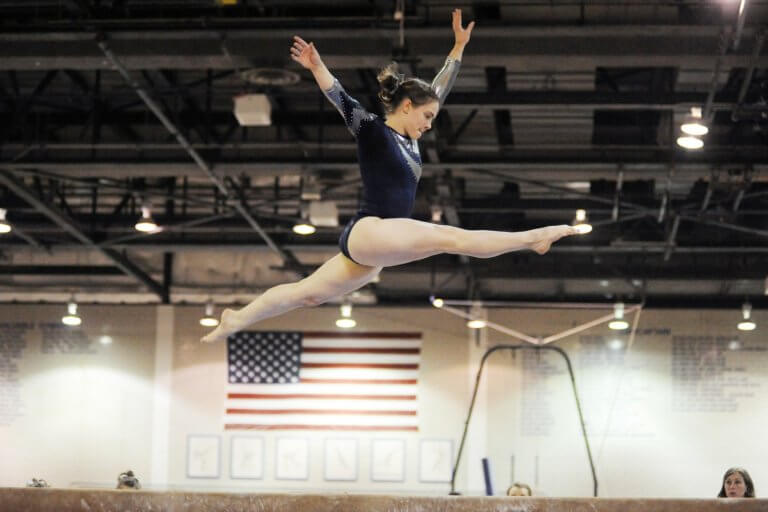“I’m not the next Usain Bolt or Michael Phelps. I’m the first Simone Biles.” – Simone Biles
Fostering gender equality in sport is about creating equal opportunities for women and men. As the Simone Biles quote above suggests, it’s not about women mirroring the success of male athletes, it’s about allowing women in sports to compete on the same stage.
In this way, living legends like Simone Biles can forge their own identity and create their own stories.
We’ve previously detailed how women in sports have been trail blazers to overcome the odds. What we intend to do with this article is take a look at how women’s equality in sports is progressing.
We’re also going to share 5 ideas to help grow female sports audiences with the aim of helping correct gender inequality in sports media coverage.
High School Gender Inequality in Sports
There are more girls playing high school sport today than years past. However, there is still a long way to go in order to create equal opportunity for young women in high school.
According to Title IX, high schools are providing 1.3 Million less opportunities for young women in America.
This lack of opportunity means that fewer young girls will be able to continue participating in sports when they reach high school. As a result, they’ll lose the critical personal development opportunities that sports provides during teenage years.
But, it’s not just a lack of opportunity that plagues young women, it can also be a lack of encouragement. Specifically, a feeling that their time in sports will be short-lived once they “become a highschooler.”
According to Gatorade’s Girls In Sport study, girls aged 14 drop out of sport at 1.5 times the rate that boys do. By age 17, just over half of all young women in high school stop playing sports.
Among the biggest reasons listed for dropping out is a feeling that they have no future in sport.
How can we all work together to overcome gender inequality in sports and create a brighter sports future for girls?
The answer is complex, but part of the answer includes the celebration and recognition of the value of women in sports.
The Value of Women Playing Sports
Sports can provide a fantastic framework for youth development. That’s because children and teenagers who play sports benefit from hands-on experiences in setting and pursuing goals.
Youth that play sports often learn that it takes consistent hard work to improve their abilities. Overtime these youth can become armed with the capability to focus and develop their skills in the classroom and eventually their workplaces too.
It may not be surprising then, that an Ernst and Young study found that 94% of women in “C-Suite” leadership positions played sport.
“Sport equips you as a woman to get to the highest level of business or leadership,” says the Founder of the EY Women Athletes Business Network, Beth Brooke-Marciniak.

Similarly, The Peterson Institute for International Economics has found that girls who play sports in school tend to do better in school, resort less to drugs, and have better health than those who don’t play.
As these young women progress in their careers, PIIE found that, on average, they earn 7 percent more than their nonathletic counterparts.
It’s clear then, that the value of women in sport extends to the boardroom. By playing sport, women develop soft-skills that they can use for the rest of their lives.
Therefore, as a society we can see the growth of women’s participation in sport as a helpful strategy for diversifying leadership in the workplace.
In turn, young girls shouldn’t look at sports as a dead end. Instead, they should be taught that sports are a springboard to personal development! As we see above, this opportunity can also translate into better career growth and the potential for higher wages.
Speaking of wages, however, pay equality in sport unfortunately still lags behind other industries.
Gender Pay Inequality in Sports
Nearly all major sports do not offer equal pay for female athletes. This means that on average, female athletes make less than their male counterparts.
The gap of gender pay inequality in sports is perhaps most obvious in the World Cup for soccer. The largest soccer event (and arguably the largest sporting event) in the world pays women much less than men.
For example, in 2014 the U.S. Men’s National Team collected $9 million for finishing 11th in the World Cup. Whereas the U.S. Women’s National Team only took home $2 million for winning the 2015 Women’s World Cup.
You read that correctly. The men’s team won four and a half times more money for achieving a much less satisfactory result.
In the same 2014 Men’s World Cup, Germany took home $35 million for their championship win. That’s a payout worth seventeen and a half times more than what the women’s tournament champions received.
From examples like this, it can be fair to surmise that gender inequality in sports has a clear financial link.
If sports opportunities for women pay substantially less than men, how can women truly compete on the same stage?
As frustrating as the Women’s World Cup pay gap may be, there is some progress being made elsewhere.
Equal Pay for Women In sports
Over the past 12 years two sports have made moves to establish equal pay for female athletes. In 2007, the Wimbledon tennis championship announced that it will provide equal prizes for male and female athletes. It’s a move that all Grand Slam tennis events quickly replicated.
This outcome shows that when an influential sports event takes the lead on pay inequality in professional sports, it can have a positive domino effect.
Similarly, in 2012, the World Surf League announced that they would be making it a policy that men and women’s Championship Tour events would have equal prize money.
When equal pay is established in professional sports like this, it not only awards the professional athletes involved, it also inspires young athletes too. It shows young athletes that professional sports, although difficult, can be a viable career option for both men and women.
Update: In 2023 FIFA announced an increase in expected women’s World Cup prize money from $60 Million to $110 Million total. This announcement also included increased amenities such as dedicated base camps, the same as the camps that men’s World Cup teams enjoy. Most importantly, they plotted to the path to achieve equal prize money for men’s and women’s World Cup players by 2026 and 2027. This announcement is fantastic news for the world’s most popular sport and all its fans.
Equality for Women In Sports
Achieving equal pay in professional sports is a major step in establishing equality, however, it’s not the only area being targeted by athletes and their supporters.
In the 2018 Olympics, men and women in both skiing and snowboarding events used the same courses for big-air and half-pipe.
It took a lot of hard work and lobbying, but now women are able to show that they can “go big” and compete just as hard as men.
This means a lot to those young women aspiring to perform high-flying aerials at the Winter Olympics someday. It’s another move that not only rewards hard working female athletes today, but also future generations to come.

Gender Inequality in Sports at the Olympic Games
There has been good, consistent growth of female participation in sport at the Olympic level for many years now. At the individual country level, some countries have even been able to achieve equal representation for a single Olympic games.
One such example is Australia who sent 20 male and 20 female athletes to the Vancouver Olympics in 2010. Although this practice isn’t wide-spread, it shows that gender equality is making progress on the world-stage.
The advance toward equal representation comes thanks to numerous important women and committees putting in long, sustained efforts to promote female sport.
In October 2018, for the first time ever, women made up half of the athletes at the Youth Olympic Games in Buenos Aires.
It was the first time that overall equal representation has been achieved at the Youth Olympic Games which bodes well for future aspiring Olympians.
Most recently, the 2020 Tokyo Olympics were dubbed “the first gender equal games” after women made up 49% of all athletes. Although one could argue that it’s not a perfect 50% representation, it is certainly a strong uptick from the 43% female representation that was achieved at the PyeongChang Olympics in 2018.
Both Buenos Aires and Tokyo provide good signs that pushes for gender inequality in sports are being met with real progress.
Update: The Paris 2024 Olympics are set to achieve full gender parity in terms of the number of athletes, with 5,250 male athletes and 5,250 female athletes. This is another great step in securing meaningful, long-term gender equality in sport.
Gender Inequality In Sports Media
The Olympics is one of the few times of the year that a young female athletes can turn on the TV and see female athletics being broadcast with an equal weighting to male athletics. It provides a fantastic opportunity for young girls and boys to see the best in the world, regardless of their gender.
However, on the NCAA level, the same cannot be said. Today 3.1 million high school girls play sports compared to 4.4 million men. This means that high school girls represent approximately 41% of all high school athletes. However, the Women’s Sports Foundation reports that as recently as March 2009, network affiliates ran 60 stories on men’s NCAA basketball, and zero stories about women.
Furthermore, UNESCO reports that although women make up approximately 40% of all athletes, they receive just 4% of sports coverage. Clearly, there is a long way to rectify gender inequality in sports media coverage.
So how can it improve?

Growing Female Sports Media Coverage
It can be argued that in order to improve gender inequality in sports media coverage, female sports audiences must grow. This is based on the fact that sports coverage is in fact primarily a vehicle for advertising.
In order for networks to make money, they need to sell advertising access to the largest audiences possible.
Following this logic then, female sports leagues and events need to develop a larger audience in order to attract networks. The good news for female sports leagues is that according to a new 2021 study, women’s sport fans are 25% more likely to buy sponsor products than men. This means women’s sport fans may actually be more valuable on a per-viewer basis. As a result, audiences won’t actually have to reach the same size as men’s sport audiences in order to produce similar results for advertisers.
Regardless of per-viewer value, how do you grow female sports audiences without existing network coverage?
Obviously, there isn’t an easy solution. But we’ve identified five ideas based on real-life examples. These ideas represent a multi-pronged approach to help grow female sports audiences and improve gender inequality in sports media coverage.
1) Look for cross-over promotional opportunities with men’s sports
During the NHL’s most recent skills competition, the National Hockey League invited some of the top women’s players to compete alongside the men. Most notably, the competition saw Kendall Coyne blaze around the rink during the fastest skater competition. In the event Coyne ended up beating one of the fastest men in the league, placing seventh out of eight.
This was the perfect opportunity to highlight women’s hockey with the world watching and the NHL seized it. Hopefully, we’ll see similar moves from other major sports leagues in the near future.
Update: In 2020, the NHL increased participation for women’s professional hockey players with an Elite 3-on-3 tournament at the NHL All-start game. This was the first time women’s professional hockey players had their own dedicated NHL All-star event, and it’s something that has continued through 2023.
2) Get the star athletes involved
In Canada, some of the greatest figure skaters in the history of the sport joined forces to produce a special touring show called the “Thank You Canada Tour.” The show performed in front of numerous audiences across the country as a special thank you for all the support each skater has received in achieving their national, world, and Olympic dreams.
This show featured the best male, female and pairs skaters in one program. As a result, figure skating fans were able to enjoy the talents of both men and women at once.
Plainly put, if more sports create performances that showcased stars from women’s and men’s leagues together, more fans could enjoy the talents of both! We’d love to see this effort replicated to help improve gender inequality in sports around the world.
3) Apply for funding
The government of Canada made a long-term target to increase the gender balance in sport by 2035. To begin, they committed to spending $30 million over three years, according to their 2018 budget. By applying for this funding, women’s sports leagues and programs can help improve athlete development, retention and promotion.
Not every government will make this a priority, but when such grants are available, they can be a great financial driver for change.
4) Take your kids to watch women’s sports
Of course, every big shift starts with a grass roots movement. In order to really encourage a generational shift, parents can seek out opportunities to take their kids to watch young women competing in various levels of sport.
For young daughters, watching women compete in sports may also increase their own participation. But, if your daughter doesn’t want to play a sport, she may still be interested in following along with local or national women’s competitors. Regardless, by introducing kids to women’s sports, you may just create life-long fans!
5) Go directly to the most passionate fans
All sports should make it easy for existing audiences to share sports clips across social media. As we mentioned above, each generational shift starts with a grass roots movement. Empowering the most passionate fans with easy-to-share sports clips is a great way to let fans promote women’s sport!
In today’s social media-centric landscape, it only takes one viral video to draw interest from tens of millions of people. Just ask UCLA and their gymnastics team captain, Katelyn Ohashi. In January, 2019, Ohashi performed the following flawless, high-energy routine to score a perfect 10. Take a look!
Katelyn’s amazing feats and infectious energy made the routine go viral. Highlights from the routine appeared world-wide on news sites and even network television like ABC News. All in all, the above video has racked up over 235 Million views, reaching new fans in the process.
Amazing performances are delivered by talented athletes all the time, but not all of them can be shared like this one. The more we make outstanding performances like Katelyn’s accessible to wide audiences, the more likely female sports audiences are able to grow!
As female sports audiences grow, athletes can leverage this larger reach to continue to improve upon gender inequality in sports.
The Future of Women’s Sport is Bright
Female equality in sports is growing as women in sport continue to blaze trails and clear hurdles. But there is still much work to be done. The more we come together to highlight women in sports, the more likely young girls will realize the bright future sports offers.
Sharing local women’s sports news and supporting female competitors can have a significant impact and create a ripple effect of change. When we take our daughters to watch women in sports, we introduce them to potential role models. These athletes may inspire our child’s own athletic pursuits, or even a life-long love of their own personal development.









